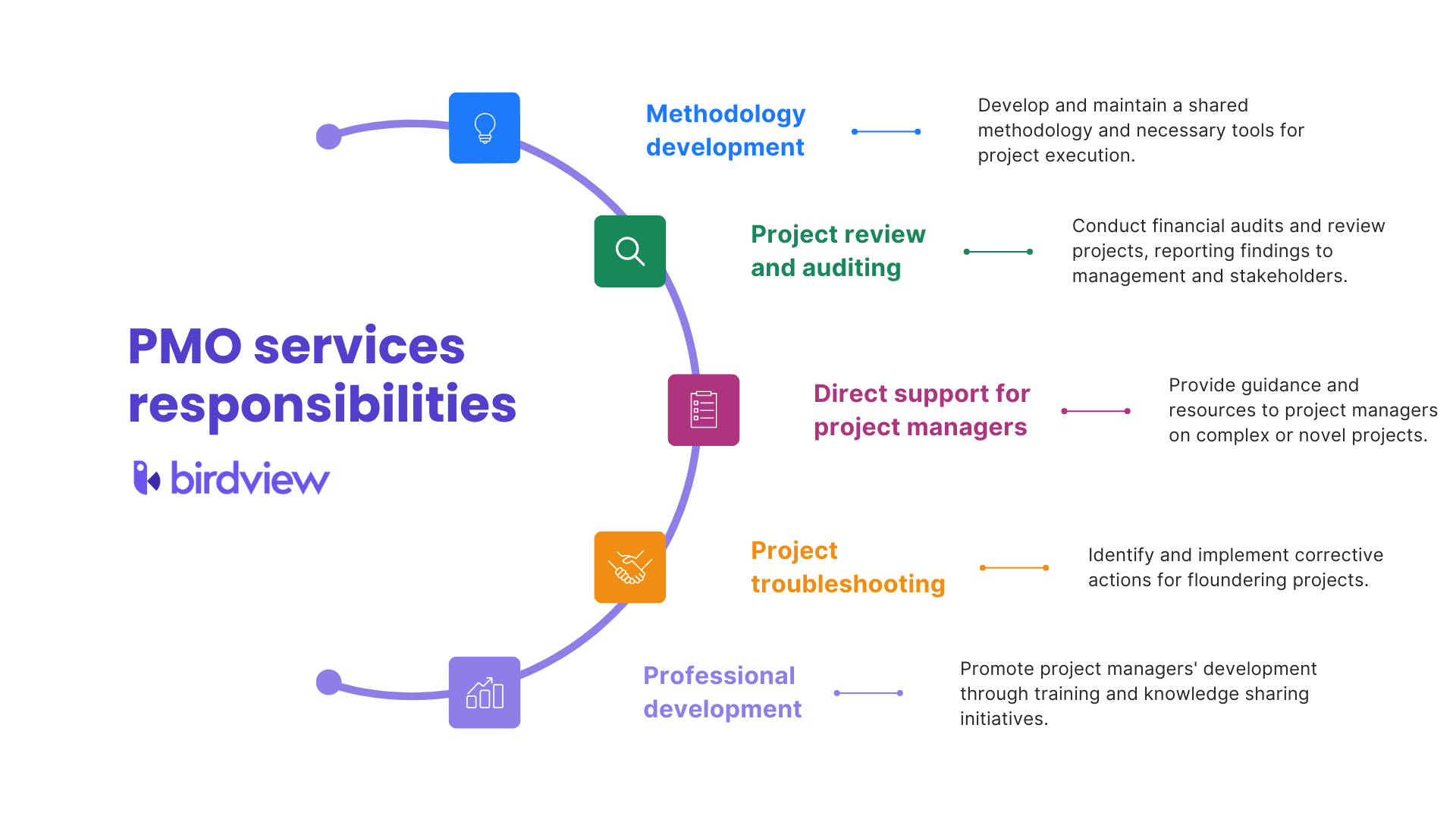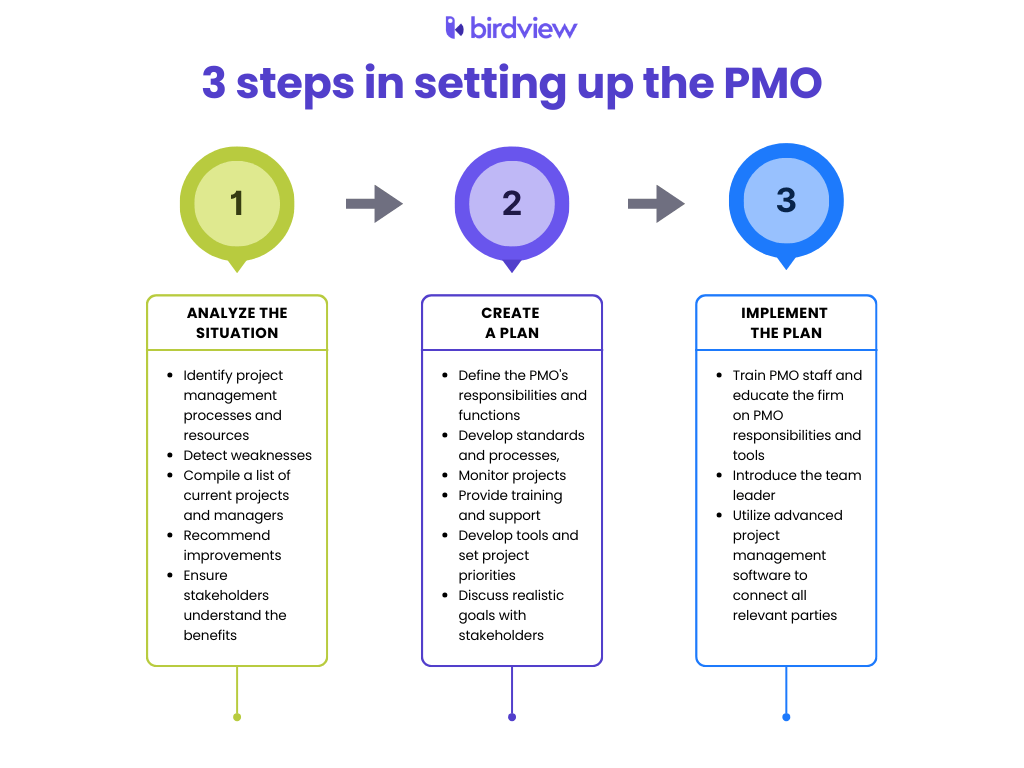In today’s fast-paced business environment, ensuring the smooth execution of projects is critical for success. This is where Project Management Office (PMO) services come into play. PMO services provide a structured approach to project management, ensuring that projects are delivered on time, within budget, and to the desired quality standards.
This article explores the role and benefits of PMOs in professional service industries like engineering, IT services, and business consulting, and shares real examples of PMO implementation within each industry.
Understanding PMO services
The project management office (PMO) is typically an operating unit of a professional services firm. The “classic” such firm, in a way, is the consultancy, for which the client “is” the project. However, any project-based company in fields ranging from architecture to law to tax return is a natural candidate.
To enhance project management in an organization, a PMO offers a variety of services. Essential aspects covered by these services include planning and scheduling projects, managing resources, mitigating risks, ensuring quality, and measuring performance.
Creating uniform project management practices is the core aim of a PMO, which boosts the efficiency and effectiveness of project execution. Establishing a centralized framework ensures that projects are better aligned with the organization’s strategic goals, leading to superior outcomes and added value.
PMO services role and responsibility
Of course, the role of PMO is to contribute to the organization‘s effectiveness and cost-efficiency in achieving its goals. The challenge is to define how the PMO can deliver those benefits. The professional services organization director may not know because, traditionally, project management has been decentralized to the level of the individual project manager. If there are shared standards and a shared methodology among managers, it is thanks to the initiative (in the spare time) of managers.
The move to systematize and institutionalize excellence in carrying out projects must motivate the investment of time and money to create a functioning PMO. Study after study has shown that a PMO‘s existence correlates with project success and should provide that motivation.

What are some core functions or responsibilities of the PMO? A typical list might include the following:
- Work out a shared, articulated methodology for delivering on project goals and identify and develop the needed tools.
- Review projects, including a financial audit, and report to management and other stakeholders.
- Step in to support more directly those project managers assigned to complex, perhaps novel, projects.
- Troubleshoot projects that are floundering.
- Promote project managers‘ professional development by supporting training and assigning priority to developing and sharing new knowledge.
Read more: What is a PMO? Roles, Responsibilities, Techniques & Benefits
What are the benefits of the PMO for professional services organizations?
The Technology Services Association (TSIA) gathered data from professional services organizations over many years and, in 2014 produced a definitive report on the benefits of the PMO. These included a significant impact on the schedule and budget of projects–both critical measures of project success. One estimate is that a ratio of one PMO professional to 100 members of a firm can produce a return on investment (ROI) representing a 1- 5% improvement in margins. That is a considerable range and may depend upon how long the PMO has been established, but even at the low end, the cost of operating the PMO should pay for itself.
Let’s look in a bit more detail at some benefits a PMO can deliver to the organization:
- A PMO can take a perspective that considers a project or portfolio of projects in the context of organizational strategy and long-term goals and plans. With this information, specific decisions about projects can be more efficient.
- The PMO‘s core responsibility is to track all firm projects, implement a metric for assessing project progress, scheduling, budgeting, and other parameters–and act quickly to flag projects going off the rails. Potential project failures are headed off.
The same company-wide perspective of the PMO and its portfolio reveals how seemingly diverse projects may impact one another. It supports the PMO‘s core responsibility to balance projects with available resources across the entire firm. Where a firm is fortunate enough to have an unlimited potential portfolio of projects but necessarily limited staff, time, and other resources to carry them out successfully, the PMO must align projects and resources for optimal productivity. Over the longer term, this alignment can involve decisions on training, purchase of project management tools, and identification of required overall management systems.
Read more: Benefits of Professional Services Automation Software
PMO services in professional services industries
Professional service industries, such as engineering, IT services, business consulting, marketing, and architecture, operate in highly dynamic and competitive environments. These industries are characterized by complex projects, tight deadlines, and the need for specialized expertise. To navigate these challenges faced by professional services industry successfully, organizations must adopt effective project management practices. This is where Project Management Office (PMO) services come into play.
From improving project success rates in engineering to enhancing resource management in IT services, PMO services offer a multitude of advantages that drive business success. Let’s take a look at how PMO services can be effectively applied across these diverse professional service industries.
Read more: 5 Risks to the Growth of Managed IT Service Providers
PMO services and Project Management Consulting
The writer worked for an extended period in two firms that may broaden the concept of the PMO. Project Management Consulting firms often operate with a high degree of variability and complexity, handling diverse projects that range in scope and duration. This section examines how a PMO can be beneficial in such environments, drawing from the experiences of two distinct organizations: a fundraising consultancy and a grant-making foundation.
Transforming fundraising consultancy with PMO
A leading fundraising consultancy firm had every aspect of their work project-based. Consultants approached potential clients, prepared proposals and budgets for services, implemented steps such as “prospect research,” delivered services such as fundraising office audit or staff and volunteer training, arranged for the creation of campaign case statements, and much more. The duration of the project could be three years. Success was raising the targeted amount of the campaign. Consultants differed in their experience, clients differed enormously in size, and fund-raising offices (the real “client”) ranged from two or three professionals to hundreds.
The consulting firm‘s reputation depended upon delivering a highly consistent, predictable level of excellence and success. For many years, the office of the financial vice president tried to impose some consistency on projects.
Challenges faced by the organization:
- Variability in consultant expertise made it difficult to ensure consistent service quality.
- The wide range of client sizes required tailored approaches, complicating standardization efforts.
- Differences in the size and capability of client fundraising offices added complexity to project management.
- Initially, there was no centralized system to enforce uniform standards and practices.
- Inefficient assignment of personnel to projects led to suboptimal resource utilization.
Eventually, the firm established an “Office of Client Services Management” – effectively a PMO – to standardize processes and ensure consistent delivery of high-quality services.
These were the results of establishing and effective PMO:
- The PMO ensured that all projects met a high standard of quality, which was crucial for client retention and success.
- By implementing standardized procedures and best practices, the firm achieved greater efficiency, reducing costs and increasing profit margins.
- The PMO facilitated optimal resource allocation, ensuring that the right personnel were assigned to the right projects at the right times.
Optimizing grant-making foundation processes through PMO
A leading New York City grant-making foundation supporting health care services and medical education. Program officers often created programs and issued a request for proposals to likely applicants for a grant. They divided the workload of preliminary and then full proposals received, did the initial assessment, assigned promising proposals to outside reviewers, used the reviews to make a final selection of proposals, negotiated budgets with the applicants, and wrote up a recommendation for each proposal grant to present to the board of directors for a vote.
Challenges faced by the organization:
- Program officers did not see themselves as project managers and lacked formal project management training.
- There were no shared procedures or success metrics for managing grants and programs.
- Evaluation methods varied widely, with no standardized criteria to assess project success.
- Inefficient management of program officers and external reviewers led to uneven workload distribution.
- The grants management office focused only on administrative tasks, without overseeing project execution or evaluation.
These are only some of the PMO benefits for grant-making foundations:
- Implementing a PMO could have introduced formal procedures, ensuring consistency and reliability in grant management.
- Establishing success criteria and metrics could help in evaluating the effectiveness of funded projects.
- A PMO could optimize resource allocation, ensuring that program officers and reviewers were efficiently managed.
These two examples highlight the diverse applicability and benefits of a PMO. While the fundraising consultancy realized the need for a PMO to maintain service quality and efficiency, the grant-making foundation’s lack of standardized procedures and success metrics pointed to potential areas where a PMO could add value.
Consistency, shared standards, and repeatability are essential for delivering high-quality services and achieving organizational goals. A well-implemented PMO ensures that projects are managed effectively, resources are used optimally, and success is consistently achieved across the board.
Read more: Professional Services Resource Management – Ultimate Guide
PMO services and Engineering
In the engineering sector, PMO services play a crucial role in ensuring complex projects are completed on time and within budget, and to the required quality standards. Engineering projects often involve intricate technical requirements, multiple stakeholders, and stringent regulatory compliance. The PMO supports engineering teams by:
- Creating detailed engineering project plans that outline tasks, timelines, and milestones.
- Managing and allocating resources such as personnel, equipment, and materials efficiently.
- Identifying potential risks and developing mitigation strategies to address them proactively.
- Implementing quality assurance processes to ensure that deliverables meet specified standards and regulations.
- Facilitating communication and collaboration among cross-functional teams to ensure alignment and resolve issues promptly.
By standardizing processes and providing specialized tools, the PMO helps engineering teams manage technical challenges effectively and deliver innovative solutions that meet client expectations.
PMO‘s use for large-scale construction projects
An infrastructure development firm specializing in large-scale construction projects faced significant challenges in managing multiple, complex projects simultaneously. The firm needed a robust system to ensure projects were completed on time, within budget, and to the highest quality standards.
Challenges faced by the organization:
- Coordination of multiple projects with diverse requirements.
- Frequent delays and budget overruns.
- Inconsistent quality and safety standards.
To address these issues, the firm established a PMO with a focus on enhancing project planning, risk management, and quality assurance.
- Project planning and scheduling
The PMO introduced detailed project planning processes, creating comprehensive timelines and milestones for each project. This ensured a consistent approach to scheduling and allowed for better tracking of project progress.
- Risk management
A thorough risk assessment framework was developed, enabling the early identification of potential issues and the formulation of effective mitigation strategies. This proactive approach helped minimize disruptions and keep projects on track.
- Quality assurance
The PMO implemented standardized quality control measures across all projects. This included regular audits and inspections to ensure compliance with industry standards and client specifications.
This case study demonstrates how a well-structured PMO can transform project management in an infrastructure development firm, leading to more reliable and successful project outcomes:
- Projects were completed more efficiently, with a significant reduction in delays.
- Better communication channels and coordination among teams led to smoother project execution.
- Consistent quality assurance practices resulted in high-quality outputs that met or exceeded client expectations.
Read more: Engineering Project Management: a Complete Guide
Engineering resources planning. 4 ways to plan limited resources
PMO services and IT services
In the IT services industry, PMO services are essential for managing rapidly changing technology, cybersecurity threats, and complex client requirements. PMO services tailored for IT projects include:
- Adopting agile methodologies to improve flexibility and responsiveness to change.
- Prioritizing and managing a portfolio of projects to ensure alignment with strategic goals.
- Handling changes in project scope, technology, and client requirements effectively.
- Ensuring that all projects adhere to cybersecurity and regulatory standards.
By providing a structured framework for managing technology projects, the PMO helps IT teams deliver innovative solutions that meet client needs while staying ahead of technological advancements.
Overcoming delays and budget overruns in software development firm
A software development firm struggled with managing multiple projects concurrently, often facing delays and budget overruns. The firm needed a systematic approach to enhance project management and improve delivery timelines.
Challenges:
- Frequent changes in project scope and requirements.
- Difficulty in managing resource allocation across projects.
- Inconsistent project delivery timelines.
To address these challenges, the firm implemented a PMO with a focus on agile methodologies, resource management, and performance tracking.
- Agile methodologies
The PMO introduced agile frameworks, such as Scrum, to improve project flexibility and responsiveness to changing requirements. Regular sprint reviews and retrospectives ensured continuous improvement.
- Resource management
The PMO optimized resource allocation, ensuring that the right talent was assigned to the right projects. This included dynamic resource planning to address changing project needs.
- Performance tracking
The PMO implemented robust performance tracking systems, using metrics and regular reporting to monitor project progress. This allowed for timely interventions and adjustments.
This case study demonstrates how a PMO can transform project management in a software development firm, leading to more reliable and successful project outcomes:
- Projects were delivered more efficiently, with improved adherence to timelines.
- Better resource management led to optimal utilization of talent and reduced bottlenecks.
- Continuous improvement practices enhanced overall project quality and client satisfaction.
Read more: Best IT Project Management Software: 2025 Picks
What are the steps in setting up the PMO?
As you begin planning a PMO for your organization, you soon realize that this, too, is a project. It will require that you analyze the organization‘s current state of affairs, create a plan that responds to that reality, and then implement it.
Early in this three-step process, you will have to identify the individual in management who can grasp and articulate the nature of the project and become fully committed to it.

1. Analyze the situation
Analyzing the situation in the organization requires identifying broadly how projects are managed, the processes, and what resources are brought to bear. Obviously, you are alert to any weakness–inconsistencies in delivery, varying records of success, any pattern in failed or uncompleted projects. Turning from the general, you will want to look at individual projects, too, and compile an up-to-date list of projects and their managers. Who is working on what and at what stage?
Your goal will be to recommend and make a case for improvements, but recognizing success and achievements and avoiding blame that can alienate potential stakeholders in a PMO. They will need to understand what the change will mean for them and how each will benefit.
2. Create a plan
Creating a plan returns us to earlier issues discussed here. What will be the areas of responsibility of the PMO? What functions must it be prepared to perform? Where does it fit in the organization’s hierarchy of project portfolio management? Although certain broad roles are common to almost all PMOs, the differences in specific responsibilities are huge. In general terms, the PMO’s mandate is to bring consistency to the organization’s performance on all projects. To do that, it develops and articulates standards, methodologies, and processes. But it also monitors each project and the project portfolio, bringing a constantly refined assessment metric to that task. When it gets down to how it actually supports the achievement of performance goals these are among the common responsibilities of the PMO:
- Training individual project managers, including coaching and mentoring, for continued effective staff development.
- Supporting the operation of individual projects, which might include workshops but, in other cases stepping in to control a project.
- Developing tools for project managers, including the best methodological practices and processes.
- Taking a hand in setting up specific projects, but on the organization‘s level, selecting projects and assigning them priority based on cost-benefit analysis or other criteria.
With potential responsibilities ranging from details of projects to firm-wide roles in anything bearing upon delivering services, the PMO can be overloaded and set up for failure. Talk to stakeholders about realistic long-term goals versus start-up objectives that are practical. With the right staffing, the PMO learning curve may be steep, but it will exist.
3. Implement the plan
Implementing the plan for a PMO today involves some routine steps like training the PMO staff. At the same time you are setting up the PMO, you should be educating the firm, including management, about the new PMO’s areas of responsibility. That includes specifying its services, whatever is agreed to date about processes and tools of project management, and introducing the team leader.
But one decisive difference from the period I discussed at the outset of this paper is the opportunity, today, to choose from a wide selection of highly sophisticated software created specifically for project management and the roles of the PMO. The leading PMOs now are not so much “users” of information technology as they are IT platforms. To a significant extent, they exist as a kind of cyber switchboard connecting project managers, clients, the PMO staff, and other resource providers requiring information and results of analyses.
Any effective PMO will need a software package with features such as task management, workflow management, and planning tools. That, of course, is just the beginning. The PMO project management team and the project teams must collaborate on their ongoing projects to understand their impact on each other. This is the reality underlying the goals of ensuring the project processes are standardized and meet the firm’s objectives and long-term goals. A kind of checklist of software requirements might include:
- PMO or EPMO (enterprise PMO) software that works in real-time, providing a view of what is happening now and collaborating with other teams.
- Software that facilitates a view of the entire project portfolio on the screen to make evident how projects relate to one another.
- Along with this high-level oversight of portfolio progress, the PMO needs to monitor many very specific projects and tasks if it is to standardize processes. This means a view at the project task level.
- Any PMO must have a role in aligning resources (staff, equipment) with projects to keep each project on schedule. A challenge is always to balance resources so that, as far as possible, every project has the resources it needs on time. The same challenge is to ensure that the workloads of individual managers and teams are balanced.
- Software ought to make possible a focus specifically on teams, the real working unit of most professional services organizations. Within the team as well as across the firm, the PMO needs to attend to the balance of workloads and timely availability of resources.
- The product of the PMO, in a sense, is the report to management, but also to project managers and teams on the progress of every project and the project portfolio. The reports should be easy to download and share.
When it comes to investing in the resources that your PMO requires to succeed, the Birdview PSA project portfolio management software package can give your service organization the best chance of success.
With its comprehensive enterprise-ready set of tools, it will help PMOs:
- Manage multiple strategic initiatives, programs, and ad-hoc projects;
- Enable real-time capacity and resource planning;
- Gain visibility into all resources and efforts;
- Instill accountability across all teams and departments.

Be sure to check back here regularly for information, insights, and updates on the state-of-the-art project portfolio management and the software that makes it easy to succeed. Sign up for a trial or request a demo tour today to learn more about Birdview PSA.
Evolve your PMO into a business growth hub
or
What are the pivot points in setting up the PMO?
The introduction of a PMO into an established and successful professional services organization with seasoned project managers and a strong profitability record must overcome inevitable opposition. Some necessary changes will be unpopular. The changes will not succeed if the individual appointed to lead the team is not talented and/or highly experienced in change management. In any case, that individual must be backed by management and have well-understood responsibilities, competency, and standing in the management hierarchy.
The PMO itself obviously is a change agent in the organization. There will be a transition period. The PMO will fail if proprietorship on the part of project managers and teams, territoriality, prevents transparency of the project process from end to end. If that transparency has not been part of the company’s culture, then top management must prioritize (and reward) it.
The first pivot point in the progress of the PMO will be when the benefits of its efforts for particular projects are seen. That is the first step in genuine understanding and acceptance of why the PMO exists. It is the final argument against skeptics.
Best practices for implementing PMO services across professional services industries
Implementing PMO services effectively requires a tailored approach that considers the unique challenges and requirements of each industry. Here are some best practices to ensure successful implementation across various professional service industries:
Understand industry-specific needs
Each industry has its own set of challenges and requirements. Conduct a thorough analysis to understand the specific needs of your industry, such as regulatory compliance in engineering or creative flexibility in marketing.
Standardize processes and methodologies
Develop standardized project management processes and methodologies that can be adapted to different projects. This ensures consistency and improves efficiency across the organization.
Foster strong leadership support
Successful PMO implementation requires strong support from senior leadership. Ensure that executives understand the value of PMO services and are committed to providing the necessary resources and support.
Invest in training and development
Equip your team with the skills and knowledge required to manage projects effectively. Provide ongoing training and development opportunities to keep them up-to-date with the latest project management practices and tools.
Implement robust performance measurement
Establish key performance indicators (KPIs) and metrics to track project performance. Use these metrics to provide regular feedback to project teams and stakeholders, ensuring continuous improvement.
Focus on communication and collaboration
Effective communication and collaboration are critical to project success. Use collaboration tools and platforms to enhance teamwork and ensure that all stakeholders are well-informed and aligned.
Leverage technology
Use project management software and tools to streamline processes, enhance communication, and improve overall efficiency. Select tools that are suitable for your industry and can be integrated with existing systems.
Promote a culture of continuous improvement
Encourage a culture where team members are always looking for ways to improve processes and outcomes. Regularly review and refine your project management practices based on feedback and performance data.
Read more: How to implement Professional Services Automation (PSA) software?
Final thoughts on the future of PMO in professional service industries
As professional service industries continue to evolve, the importance of PMO services in driving project success and delivering value will only grow. PMOs will need to adapt to an increasingly dynamic and complex business environment, incorporating agile methodologies, advanced technologies, and a greater emphasis on strategic alignment. By fostering a culture of continuous improvement and leveraging data analytics and predictive tools, PMOs can enhance their ability to manage risks, optimize resources, and ensure that projects contribute to the organization‘s long-term goals.
Your PMO’s success depends
on the right project management software
or
You may be interested in...
Best professional services billing solutions – Top picks for 2025
Best Consulting Project Management Software: 2025 Picks
Best PSA Software and Tools 2025
6 KPIs for Professional Services Firms in 2025



